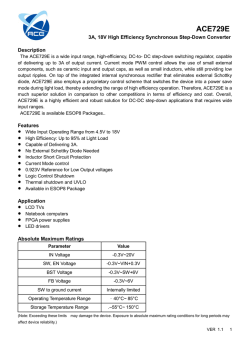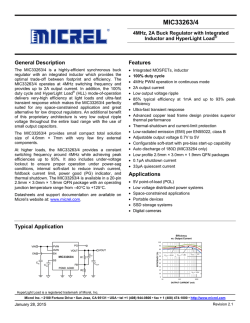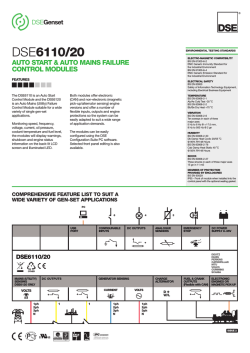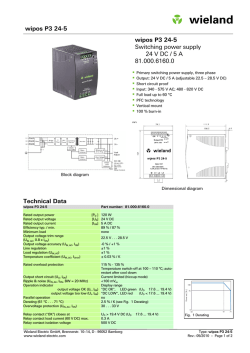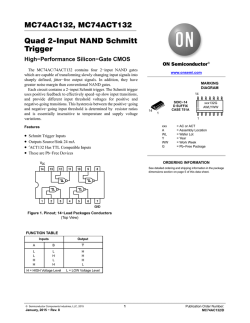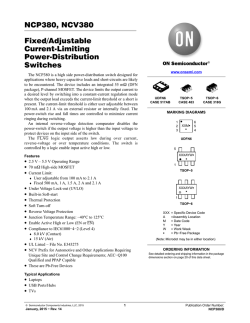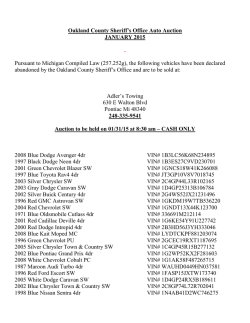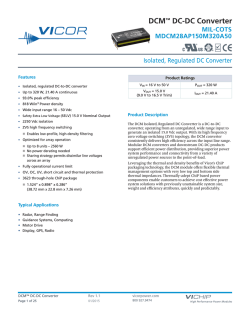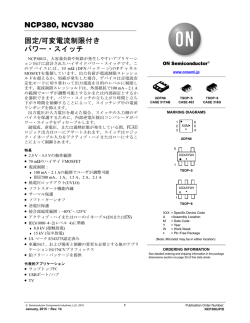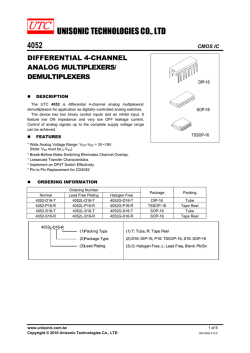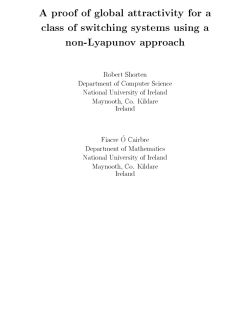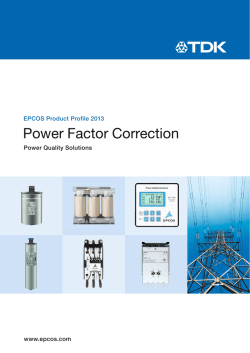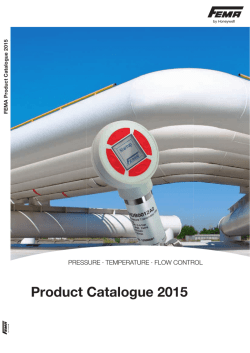
ACE732E - ACE Technology
ACE732E 6V/3.5A, Fast Response, Step-Down Converter Description ACE732E belongs to a new breed of high frequency synchronous Step-Down converter that combines the advantages of voltage mode control and Constant-On-Time control. Its adaptive Constant-On-Time control dynamically changes switch on time to achieve a constant switching frequency. It does not have the minimum on-time constrain normally a fixed-frequency current mode Step-down requires, allowing it to go down to very low duty ratio without affecting loop stability. The voltage mode nature of ACE732E also provides a more superior load transient response and a seamless transition from PFM to PWM modes. ACE732E is capable of supplying output with current up to 3.5A at 1.2V output. All these features make ACE732E an excellent choice for ARM based CPU power supply. Features • • • • • • • Adaptive COT control Up to 95% Efficiency Up to 91% Efficiency for low output voltage Up to 3.5A Max Output current Feedback voltage 0.45V Excellent load transient response DFN2X2-8L Package Application • • • • ARM based CPUs Tablet, MID Smart Phone Smart Set-Top Box, OTT Absolute Maximum Rating Parameter Value VIN Voltage -0.3V~6V All Other Pin Voltage VIN-0.3V~VIN0.3V SW to ground current Internally limited Operating Temperature Range -40°C~85°C Storage Temperature Range -55°C~150°C Thermal Resistance θJA 75 °C /W Note: Exceed these limits to damage to the device. Exposure to absolute maximum rating conditions may affect device reliability. VER 1.1 1 ACE732E 6V/3.5A, Fast Response, Step-Down Converter Typical Application ACE732E Typical Application Circuit of 1.2V Output Packaging Type EN VIN PGND SW AGND NC FB VOS DFN2x2-8L DFN2x2-8 Description Function 1 EN PGND Enable pin for the IC. Drive this pin to high to enable the part, low to disable 2 3 AGND 4 FB 5 VOS 6 NC 7 SW 8 VIN Power Ground. The ground of internal power NMOS. Bypass with a 22μF ceramic capacitor to VIN Analog Ground. To keep this ground free from noise by connecting a 10nF ceramic capacitor to VIN. Do not short his pin to PGND directly in PCB, but through a PCB trace to connect the 2 GND together. Feedback Input. Connect an external resistor divider from the output to FB and GND to set the output to a voltage between 0.45V and VIN Output voltage sense pin, to be connected to the output node of regulator. Not connected. Please do leave this pin float. Inductor Connection. Connect an 1uH inductor Between SW and the regulator output. Supply Voltage. Bypass with a 22μF ceramic capacitor to PGND and 10nF to AGND. VER 1.1 2 ACE732E 6V/3.5A, Fast Response, Step-Down Converter Ordering information ACE732E XX XX + H Halogen - free Pb - free DN: DFN2*2-8L ADJ: Adjustable Voltage Block Diagram Electrical Characteristics VIN=VEN=5, TA=25°C Parameter Input Voltage Range Conditions Min Typ 2.6 Max Unit 5.5 V Input UVLO Rising, Hysteresis=250mV 2.15 V Input OVP 6.25 V Input Supply Current Rising, Hysteresis=200mV VFB =0.5V, Device Not Switching 50 uA Input Shutdown Current EN=GND 0.1 1 uA 0.45 0.464 V FB Feedback Voltage 0.436 FB Input Current 0.01 Output Voltage Range 0.45 Load Regulation Line Regulation VIN =3V to 4V uA VIN 0.18 V %A 0.1 %V VER 1.1 3 ACE732E 6V/3.5A, Fast Response, Step-Down Converter Switching Frequency 1.0 1.5 2.0 MHz PMOS Switch On Resistance ISW =200mA 120 mΩ NMOS Switch On Resistance ISW =200mA 60 mΩ PMOS Switch Current Limit VIN =5V 4.5 A SW Leakage Current VIN=5.5V,VSW=0 or 5.5V,EN= GND 4 EN Input Current EN Input Low Voltage uA 1 uA 0.4 V EN Input High Voltage Thermal Shutdown 10 1.5 Rising, Hysteresis =20°C 155 V °C Typical Characteristics (Typical values are at TA=25°C unless otherwise specified) Efficiency Vs Iout, Vout=3.3V Efficiency Vs Iout, Vout=1.2V Output Voltage Vs Iout, Vout=3.3V Output Voltage Vs Iout, Vout=1.2V VER 1.1 4 ACE732E 6V/3.5A, Fast Response, Step-Down Converter Vout Vs. Vin, Iout=0 Switching Frequency Vs. Ambient Temperature Switching Waveform: VIN=5V, VOUT=1.2V, IOUT=0 mA Iq Vs. Temperautre, Iout=0 and In Switching Maximum Iout Vs. Ambient Temperature Switching Waveform: VIN=5V, VOUT=1.2V, IOUT= 3A VER 1.1 5 ACE732E 6V/3.5A, Fast Response, Step-Down Converter Transient Response: VIN=5V, VOUT=1.2V, IOUT=0.3-3A Output Short Response: VIN=5V, VOUT=1.2V, Output short to GND FUNCTIONAL DECRIPTIONS ACE732E belongs to a new breed of high frequency synchronous Step-Down converter that combines the advantages of voltage mode control and Constant On time control. Its adaptive Constant-On-Time control dynamically changes switch on time to achieve a constant switching frequency. It does not have the minimum on-time constrain normally a fixed-frequency current mode Step-down requires, allowing it to go down to very low duty ratios without affecting loop stability. The voltage mode nature of ACE732E also provides a more superior load transient response as well as a seamless transition from PFM to PWM modes. It can also operate up to 100% duty. It has a cycle by cycle current limit and a hiccup mode that protects against dead-short condition. It includes soft-start, UVLO and thermal shutdown protection. Adaptive Constant On-Time Control ACE732E uses an adaptive Constant-On-Time control scheme that the ON time is dynamically adjusted according to VIN and VOUT so to achieve a nearly constant switching frequency. This control scheme provides simpler compensation and superior transient response over traditional constant frequency current mode control, while still maintaining the advantage of switching at a constant frequency at about 1.5MHz. It also provides a seamless transition from PFM to PWM that normally a constant frequency current mode control scheme is hard to achieve. Further mode, because it is a COT control scheme, the system can achieve high step-down ratio at ease, because lower constrain on the minimum on- time requirement existing in constant frequency scheme. 100% Duty operation ACE732E can operate at 100% duty cycle under dropout condition for high efficiency purpose. Current Limit and Short-Circuit protection ACE732E employs a cycle-by-cycle peak current limit and it also has a hiccup mode that protects the circuit during dead-short condition. When the dead-short condition is removed, the IC goes back to normal operation. Soft-start ACE732E has an internal soft-start circuitry to reduce supply inrush current during startup conditions. When the device exits under-voltage lockout (UVLO), shutdown mode, or restarts following a VER 1.1 6 ACE732E 6V/3.5A, Fast Response, Step-Down Converter thermal-overload event, the l soft-start circuitry slowly ramps up current available at SW. UVLO and Thermal Shutdown If IN drops below UVLO threshold, the UVLO circuit inhibits switching. Once IN rises above ULVO threshold, the UVLO clears, and the soft-start sequence activates. Thermal-overload protection limits total power dissipation in the device. When the junction temperature exceeds TJ=+155°C, a thermal sensor forces the device into shutdown, allowing the die to cool. The thermal sensor turns the device on again after the junction temperature cools by 15°C, resulting in a pulsed output during continuous overload conditions. Following a thermal-shutdown condition, the soft-start sequence begins. Design Procedure Setting Output Voltages Output voltages are set by external resistors. The FB threshold is 0.45V. RTOP = RBOTTOM x [(VOUT / 0.45) - 1] Inductor Selection The peak-to-peak ripple is limited to 30% of the maximum output current. This places the peak current far enough from the minimum overcurrent trip level to ensure reliable operation while providing enough current ripples for the current mode converter to operate stably. LIDEAL=(VIN(MAX)-VOUT)/IRIPPLE*DMIN*(1/FOSC) Output Capacitor Selection The output capacitor keeps output ripple small and ensures control-loop stability. The output capacitor must also have low impedance at the switching frequency. Ceramic, or a MLCC capacitors are suitable, with ceramic exhibiting the lowest ESR and high-frequency impedance. Output ripple with a ceramic output capacitor is approximately as follows: VRIPPLE = IL(PEAK)[1 / (2π x fOSC x COUT)] If the capacitor has significant ESR, the output ripple component due to capacitor ESR is as follows: VRIPPLE(ESR) = IL(PEAK) x ESR Input Capacitor Selection The input capacitor in a DC-to-DC converter reduces current peaks drawn from the battery or other input power source and reduces switching noise in the controller. The impedance of the input capacitor at the switching frequency should be less than that of the input source so high-frequency switching currents do not pass through the input source. The output capacitor keeps output ripple small and ensures control-loop stability. PCB LAYOUT The ACE732E employs a sophisticated control scheme to achieve the fast response and other superior performances. So the PCB layout is recommended to strictly follow the proposed way shown below. The Cin (22uF) and Cout (22uF or 10uF x 2) are always to be placed closest to ACE732E. The Cin1 (10nF) is also require to be connected to AGND (not PGND) to filter out the switching noise. Please don’t short Pin2 (PGND) and Pin3 (AGND) directly, but through a PCB trace, as what’s shown below. Please contact ACE engineers for confirmation if one needs to change the PCB layout. VER 1.1 7 ACE732E 6V/3.5A, Fast Response, Step-Down Converter VER 1.1 8 ACE732E 6V/3.5A, Fast Response, Step-Down Converter Packing Information DFN2x2-8L Symbol A A1 A3 b D E D2 E2 e K L R Min. 0.70 ̅— 0.15 1.90 1.90 0.50 1.10 0.40 0.20 0.30 0.09 Dimensions in millimeters Nom. 0.75 0.02 0.20REF 0.20 2.00 2.00 0.60 1.20 0.50 — 0.35 — Max. 0.80 0.05 0.25 2.10 2.10 0.70 1.30 0.60 — 0.40 — VER 1.1 9 ACE732E 6V/3.5A, Fast Response, Step-Down Converter Notes ACE does not assume any responsibility for use as critical components in life support devices or systems without the express written approval of the president and general counsel of ACE Electronics Co., LTD. As sued herein: 1. Life support devices or systems are devices or systems which, (a) are intended for surgical implant into the body, or (b) support or sustain life, and shoes failure to perform when properly used in accordance with instructions for use provided in the labeling, can be reasonably expected to result in a significant injury to the user. 2. A critical component is any component of a life support device or system whose failure to perform can be reasonably expected to cause the failure of the life support device or system, or to affect its safety or effectiveness. ACE Technology Co., LTD. http://www.ace-ele.com/ VER 1.1 10
© Copyright 2025
